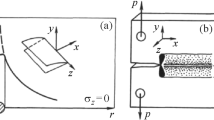Abstract
Fracture mechanisms for widely used metal materials are investigated under various loading conditions. Several specimens and different loading methods are deliberately designed to produce various stress states. The stress triaxiality is used to rate the level of tension and compression under various stress states. The stress triaxiality increases with adding a notch in the specimen under tension loading and decreases by changing the loading from tension to compression. Scanning electron microscopes are used to observe the microscopic features on the fracture surfaces. The fracture surfaces observed in the tests indicate that with the decreasing stress triaxiality the fracture mechanism for a given metal material includes intergranular cleavage, nucleation, growth, void coalescence, and local shear band expansion. With the fracture mechanisms changing from intergranular cleavage to nucleation, growth, and coalescence of voids, and expansion of a local shear band, four possible fracture modes can be observed, which are quasi-cleavage brittle fracture, normal fracture with void, shear fracture with void, and shear fracture without void. Quasi-cleavage brittle fracture and normal fracture with void are both normal stress-dominated fracture modes; however, their mechanisms are different. Shear fracture with and without void are both shear stress-dominated fracture, and shear fracture with void is also influenced by the normal stress. To a certain metal material, under high stress triaxiality, quasi-cleavage brittle fracture and normal fracture with void tend to occur, and under low stress triaxiality, shear fracture with and without void tend to occur. In addition, the critical positions and fracture criteria adapted to each fracture mode will also be different.
Similar content being viewed by others
References
Bao Y.B., Wierzbicki T.: On fracture locus in the equivalent strain and stress triaxiality space. Int. J. Mech. Sci. 46, 81–98 (2004)
Huang M.J., Man C.S.: Model verification of Lode’s test results and yield function of isotropic FCC polycrystal. Acta Mech. 209, 311–323 (2010)
Achouri M., Germain G., Santo P.D., Saidane D.: Experimental characterization and numerical modeling of micromechanical damage under different stress states. Mater. Des. 50, 207–222 (2013)
Giglio M., Manes A., Vigano F.: Ductile fracture locus of Ti6Al4V titanium alloy. Int. J. Mech. Sci. 54, 121–135 (2012)
Mostafavi M., Smith D.J., Pavier M.J.: Fracture of aluminium alloy 2024 under biaxial and triaxial loading. Eng. Fract. Mech. 78, 1705–1716 (2011)
Pedersen K.O., Hopperstad O.S.: Fracture mechanisms of aluminium alloy AA7075-T651 under various loading conditions. Mater. Des. 32, 97–107 (2011)
Mang H.A., Pichler B., Bader T., Füssl J., Jia X.: Quantification of structural and material failure mechanisms across different length scales: from instability to brittle-ductile transitions. Acta Mech. 223, 1937–1957 (2012)
Guo L.W., Yu J.L.: Bending behavior of aluminum foam-filled double cylindrical tubes. Acta Mech. 222, 233–244 (2011)
Guo W.L.: Elastoplastic three dimensional crack border field—I. Singular structure of the field. Eng. Fract. Mech. 46, 93–104 (1993)
Guo W.L.: Elasto-plastic three-dimensional crack border field—III. Fracture parameters. Eng. Fract. Mech. 51, 51–71 (1995)
Dunand M., Mohr D.: On the predictive capabilities of the shear modified Gurson and the modified Mohr–Coulomb fracture models over a wide range of stress triaxialities and Lode angles. J. Mech. Phys. Solids 59, 1374–1394 (2011)
Zhu H., Qi F.J.: Mechanical properties and fracture behaviors on 6061 aluminum alloy under shear stress state. Rare Metals 30, 550–554 (2011)
Graham S.M., Zhang T.T., Gao X.S., Hayden M.: Development of a combined tension-torsion experiment for calibration of ductile fracture models under conditions of low triaxiality. Int. J. Mech. Sci. 54, 172–181 (2012)
Li H., Fu M.W., Lu J., Yang H.: Ductile fracture: experiments and computations. Int. J. Plast. 27, 147–180 (2011)
Tang, A.M., Ji, Y.Z.: The analysis of effect factor on mixed mode fracture of LC4-M material. Chin. J. Appl. Mech. 18, 125–129 (2001) (in Chinese with English abstract)
Bao Y.B., Treitler R.: Ductile crack formation on notched Al2024-T351 bars under compression–tension loading. Mater. Sci. Eng. A Struct. 384, 385–394 (2004)
Zhu H., Zhu L., Chen J.H., Lv X.F.: Investigation of fracture mechanism of 6063 aluminium alloy under different stress states. Int. J. Fract. 146, 159–172 (2007)
El-Magd E., Abouridouane M.: Characterization, modeling and simulation of deformation and fracture behaviour of the light-weight wrought alloys under high strain rate loading. Int. J. Impact Eng. 32, 741–758 (2006)
Barsoum I., Faleskog J.: Rupture mechanisms in combined tension and shear-micromechanics. Int. J. Solids Struct. 44, 5481–5498 (2007)
Srivatsan T.S., Guruprasad G., Vasudevan V.K.: The quasi static deformation and fracture behavior of aluminum alloy 7150. Mater. Design. 29, 742–751 (2008)
Srivatsana T.S., Narendrab U.N., Troxellc J.D.: Tensile deformation and fracture behavior of an oxide dispersion strengthened copper alloy. Mater. Design. 21, 191–198 (2000)
Bridgman P.W.: Studies in Large Plastic Flow and Fracture, 1st edn. McGraw-Hill, New York (1952)
Author information
Authors and Affiliations
Corresponding author
Rights and permissions
About this article
Cite this article
Li, Z., Shi, J. & Tang, A. Investigation on fracture mechanisms of metals under various stress states. Acta Mech 225, 1867–1881 (2014). https://doi.org/10.1007/s00707-013-1024-x
Received:
Revised:
Published:
Issue Date:
DOI: https://doi.org/10.1007/s00707-013-1024-x




